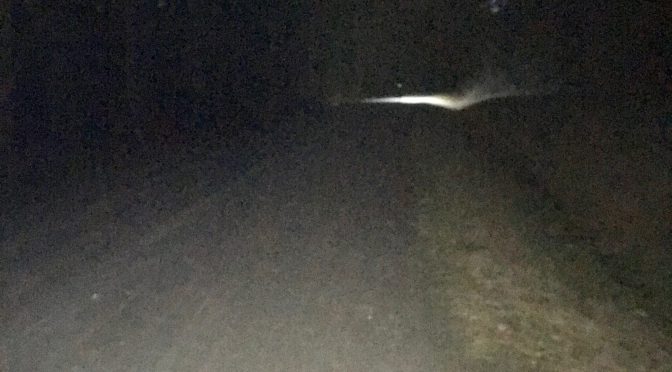It was a late November night in the late 1990s and Alan and I were hiking a stretch of the Mountains-to-Sea Trail along Falls Lake. Though we’d been mountain biking at night for two or three years, the notion of hiking in the dark had only recently occurred to us. Making our way through the woods in the quiet of night made us a bit giddy; instead of two guys in their late 40s, we were like a couple of 10-year-olds who’d snuck out of our bedroom windows on a clandestine adventure.
Clandestine, in part, because the end of Daylight Saving Time traditionally meant the end of getting in a midweek hike after work. We were supposed to concede to the night, to restrict ourselves weekend hikes only. We were expected to go into midweek hibernation.
Instead, we were reinventing the notion of winter hiking.
Cone of Solitude
On a night hike, your world is reduced to the 20-foot-or-so beam of light cast by your headlamp. Your world is shrunk to what your lumens can illuminate, and there’s a certain degree of comfort in that. Think of how overwhelming it can be navigating a crowded downtown street at lunch, or making your way through the mall on a Saturday afternoon. On the trail at night, your headlamp reduces your world to an impenetrable fortress. Maxwell Smart had his Cone of Silence, a night hike offers a cone of solitude.
Another curious thing about your 20-foot world? It actually makes hiking safer. People fear they’ll be stumbling and bumbling down the trail on a night hike, that hiking in the dark isn’t only unsafe, it’s insane. In reality, with your world reduced to the 20 feet of trail in front of you, you’re less likely to be distracted by the visual temptations beyond. At night, it’s almost instinctual that you stop whenever you’re tempted to look off trail. You trip over far fewer rocks and roots in the dark.
That said …
Not every trail is meant for a night hike. Many, for instance, have hours and it’s considered trespassing if you disregard them. Trails that have steep drops or that aren’t particularly well blazed may be off the trail as well: there’s a good deal of looking down on a night hike, making it easy to miss a subtle turn. On a night hike, you stop and take stock of your location, checking for blazes more often than you do during the day. You do a number of things differently on a night hike (for tips on how to best approach a night hike see the link to a post from last year, below).
All of this is why we suggest you tag along with us on our new monthly night hike series, which begins this month and runs through the last week of Standard Time. We know the places that are legal to hike between dusk and dawn, and for the places where it’s not allowed, we get permission. We have extra headlamps, we have extra batteries, and we’ll share some thoughts about navigating at night. If you’re intrigued by the idea of getting in a midweek hike year-round, but are hesitant about hiking in the dark on your own, it’s a good opportunity.
Besides, when was the last time you snuck out your bedroom window at night to have a little fun?
Happy trails,
Joe
Come night hike with us
In the Triangle, we’re about to launch our Tuesday Night Hikes series, one night hike a month, on a Tuesday, at a different spot around the area. It’s a good introduction for the night-hike curious. Learn more and register here.
Learn more about night hiking
Before you join us for our Tuesday Night Hikes, check out our post, Goodbye Daylight Saving Time, Hello Night Hike, from this time last year, where you’ll find tips on night hiking, from the gear you need to evaluating a good trail for night hiking, to the assorted benefits of hiking under the stars. Check it out.
Cone of Silence?
See this marvel of Cold War spy technology in action here.
